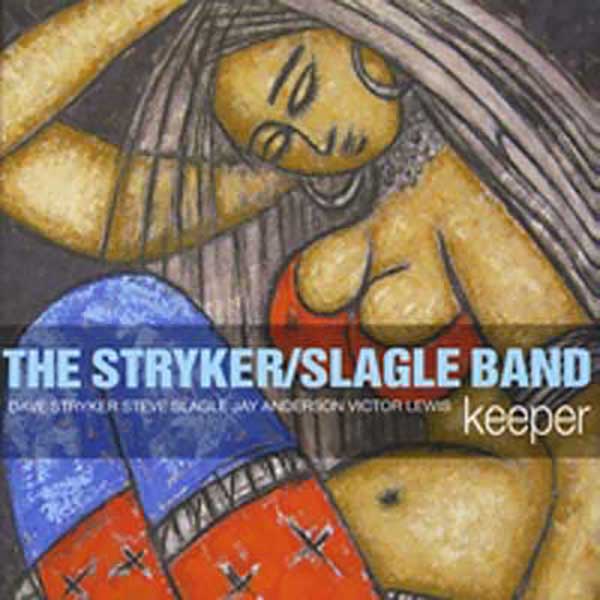
by Ian Mann
August 05, 2010
/ ALBUM
An enjoyable, swinging album with plenty to enjoy. Stryker and Slagle write catchy, accessible tunes and both play superbly throughout.
The Stryker/Slagle Band
“Keeper”
(Panorama Records PAN 003)
The Stryker/Slagle Band are an experienced quartet from the upstate New York/New England area co-led by guitarist Dave Stryker and alto saxophonist Steve Slagle. Both are established sidemen with impressive pedigrees, Stryker with Brother Jack McDuff, Stanley Turrentine, Eliane Elias and vocalist Kevin Mahogany and Slagle with Carla Bley, Charlie Haden, Steve Kuhn, Ray Barretto, Joe Lovano and the Mingus Big Band. I’m most familiar with Slagle’s playing having enjoyed his contribution to Carla Bley’s and Steve Kuhn’s groups back in the day.
“Keeper” is the fifth album from Stryker and Slagle and the third to team them with bassist Jay Anderson (at whose Mountain Rest Studio in upstate New York the album was recorded) and the much travelled drummer Victor Lewis.
The guitar/saxophone front line is still relatively uncommon and British listeners may notice a resemblance to the sound of Partisans, the group fronted by saxophonist Julian Siegel and guitarist Phil Robson. Stryker and Slagle are more rooted in the jazz tradition than Partisans and their music displays less of a rock influence. It is not lacking in urgency however and much of “Keeper” displays a certain swagger and energy, these guys are good and they know it. In a well balanced programme featuring five tunes from Stryker and four from Slagle plus Thelonious Monk’s “Ruby My Dear” they consistently keep things interesting as they explore a number of jazz styles.
The two co-leaders play particularly well together as evidenced on Stryker’s opening title track. The guitarist is influenced by Kenny Burrell and Wes Montgomery and his lively chording is the perfect foil for Slagle’s incisive alto soloing. As a soloist Stryker is full of elegant single note runs and builds his solos intelligently. “Keeper”, the track, also features a series of inventive drum breaks from the experienced Lewis, another veteran of the Carla Bley stable.
Slagle’s “Bailout” is a swinging minor blues that features some forceful blowing from the composer and some admirably nimble guitar soloing from Stryker, all propelled by Anderson’s insistent bass and Lewis’ energetic drum and cymbal work.
Monk’s “Ruby My Dear” allows the group to take their collective foot off the gas for a thoughtful reading of one Thelonious’ most beautiful tunes. Stryker and Slagle manage to bring something of themselves to the performance with the altoists’ bittersweet tone and the guitarist’s languid runs holding the attention and imparting emotional depth to the piece.
Stryker’s “Came To Believe” features the co-leaders working both in tandem and as soloists on one of Stryker’s strongest melodies. There’s a kind of breezy optimism to the tune that reflects its title with Slagle’s forceful blowing keeping the music just the right side of smooth jazz.
“Bryce’s Peace” is a dedication by Slagle to his late father, the painter Bryce Slagle who was responsible for the album’s distinctive cover art. The tune itself is a fitting homage, a ballad that features the composer’s pure toned alto and the articulate bass playing of Anderson who appears for the first time as a soloist.
Stryker’s “Blue State” (I think there’s a political joke in the title that us Brits don’t quite get) reflects the guitarist’s love of the blues and his early affection for the music of the “three kings” of blues guitar B.B., Freddie and Albert. The tune has a powerful down home groove with blues tinged alto and guitar and crisp, incisive drumming from Lewis. It’s unpretentious and fun and tilts its head in the direction of Stryker’s Nebraska roots.
Slagle honours another family member with “Sister”, a dedication to his youngest daughter. With a catchy, joyous hook it carries on where Stryker’s blues left off as the leaders solo in relaxed fashion over the rhythm section’s busy groove. There’s a second solo appearance from Anderson too.
Stryker works regularly as part of an organ trio and dedicates “Gold Dust” to the young Hammond player Jared Gold. Slagle switches to soprano here and Stryker plays nylon strung acoustic guitar on a pretty tune that reveals a very different aspect of the band’s sound.
Slagle remains on soprano for Stryker’s “Convergence”, a piece inspired by the music of pianist McCoy Tyner. Like many of the other pieces on the album it’s breezy, swinging and unpretentious and features great soloists from the two leaders. Stryker’s fleet fingered guitar work is a particular treat and Slagle’s soprano cuts like a knife. Lewis also features in a series of breaks and comes even more into his own on the closing “Good 4 U”. Slagle’s tune is a good natured Afro Cuban romp that gives the group’s star drummer plenty of scope and ends the album on a positive note.
“Keeper” is an enjoyable, swinging album with plenty to enjoy. Stryker and Slagle write catchy, accessible tunes and both play superbly throughout. The way the guitar and saxophone dovetail so beautifully illustrates just how much they enjoy making music together and is testament to a twenty year old musical partnership. Anderson and Lewis play their parts well too, but essentially this is the co-leader’s band.
This isn’t an album that’s going to change the face of jazz but its swinging, no nonsense joyousness is frequently a delight. I’d wager that they’re a great band to see live, particularly in a club setting.
blog comments powered by Disqus